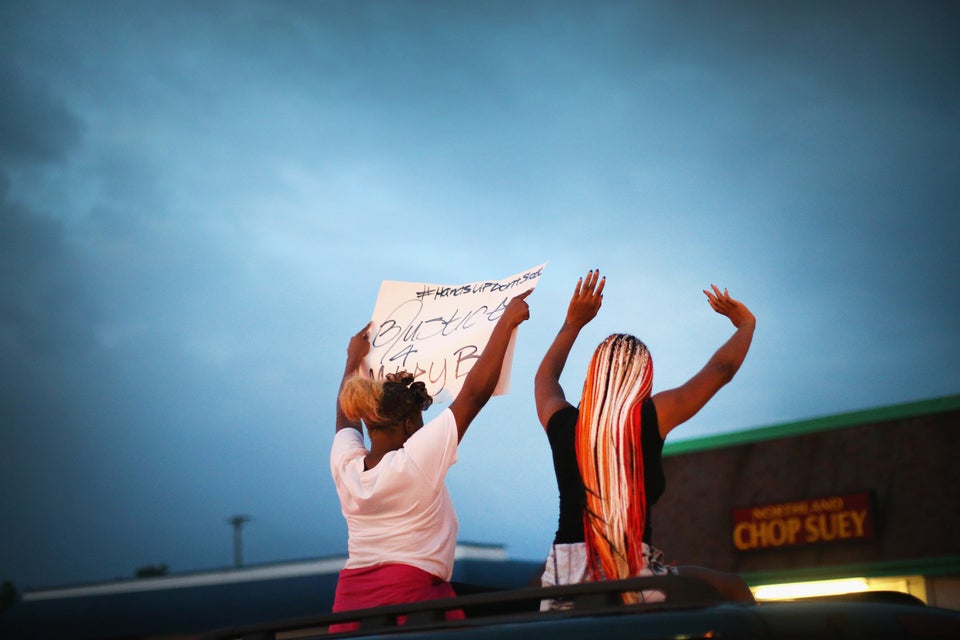ST. LOUIS -- In the summer of 1967, President Lyndon B. Johnson appointed the "National Advisory Commission on Civil Disorders" to investigate and help prevent the spread of race riots that were happening across the country. At the time, unrest had already caused extensive damage and a number of fatalities.
At the end of the seven months of work from the Kerner Commission, as it would come to be known, the 11 members came to one basic conclusion: “Our nation is moving toward two societies, one black, one white -- separate and unequal.”
Nearly 50 years later, history is repeating itself. After unrest embroiled the small town of Ferguson, Missouri, in the wake of the death of Michael Brown, an unarmed black teenager who was fatally shot by a white police officer, Gov. Jay Nixon (D) created the "Ferguson Commission." According to its website, its goal is to “guide the community in charting a new path toward healing and positive change for the residents of the St. Louis region.”
On Sept. 9, the 16-member group is having its final meeting, and it will turn in its final report to Nixon by the end of the year. But if history proves true, it's likely the report will go relatively unnoticed and not effect any major change in the community.
In the Kerner Commission's final report, the body made dozens of recommendations to state governments and the federal government, as well as to police departments, media outlets, workplaces and educational institutions. But despite the commission's work, Johnson did not act on its recommendations.
Lindsey Lupo, a political science professor at Point Loma Nazarene University and the author of Flak-Catchers: One Hundred Years of Riot Commissions in America, said commissions tend to reduce the sense of urgency and “make it seem as though the government is responding.”
“They end up depoliticized or bandaging the violence, rather than actually dealing with the underlying problems and why the violence erupted in the first place,” she said.
Two years prior to appointing the Kerner Commission, Johnson signed the Voting Rights Act, with the aim of removing barriers that had prevented black Americans from exercising their right to vote. However, blacks in the South were still being declined their right by state and local governments. And despite voting against every single civil rights proposal as a House representative, Johnson received credit during his presidency as a civil rights pioneer because he signed the Civil Rights Act of 1964.
The summary of the Kerner Commission's final report ended with a quote from Dr. Kenneth Clark, a scholar who witnessed the first commission meeting. Clark wrote the findings, like past reports, did not “uncover any startling truths, unique insights, or simple solutions.”
“The destruction and the bitterness of racial disorder, the harsh polemics of black revolt and white repression have been seen and heard before in this country,” Clark wrote. “It is time now to end the destruction and the violence, not only in the streets of the ghetto but in the lives of people.”
According to Lupo’s book, implementing a commission after a riot was common practice between 1917 and 1968. Thirty-four such commissions were formed after unrest, she wrote.
Missouri Lt. Governor Peter Kinder (R) --who voted against government funding for the Ferguson Commission -- told St. Louis Public radio that he could not find one person “Democrat, Republican or independent -- who believes that a commission sitting and taking testimony and producing a report that is going to gather dust on shelves is going to be a big part of the solution to Ferguson."
Others were more hopeful.
Unlike commissions of the past, Ferguson’s is made up of a diverse group of people, including Starsky Wilson, a pastor and the CEO of the Deaconess Foundation, and Rich McClure, the former CEO of UniGroup, a logistics company. The commission also includes law enforcement officials, a former mayor, an attorney and a protest organizer. Brittany Packnett, the St. Louis executive director of Teach for America, is one of the youngest commission members, and also served on President Barack Obama's Task Force on 21st Century Policing.
The task force provides another example of the "commission" strategy, as it was formed in the wake of the Ferguson protests and other officer-involved shootings around the country. The group released a report recommending six pillars of improvement, including that officers wear body cameras and get more sleep.
But like the Kerner Commission, the task force simply called orders into the air, without having anyone to make sure that various agencies and groups would fulfill the action plan they received. The task force, which interviewed citizens, held all-too-common town hall meetings and relied heavily on the government to implement its recommended policies. It has been months since the final report came out in May, and it seems to have been easily forgotten.
Lupo said implementation is probably the hardest stage for commissioners to process. “Policymakers are not accountable to commissions once they report. The commission process does not set up post-report procedures checking in on implementation,” she said.
Reflecting on past commissions, Lupo said she couldn't "point to any of them that saw real policy implementation occur after the release of the report."
Another example of the commission strategy is the McCone Commission, installed following the Watts Riots in the 1960s. It managed to get a few policies, like a transportation grant, implemented, but Lupo said the small changes were “piecemeal tokens” that “didn’t even come close to tackling this deeply embedded problem that the community had with education and racial inequality.”
The Ferguson Commission has had several meetings. All have been similar: A public poll of the audience takes place, followed by public comments. The commission then reviews a racial and economic disparity topic, and usually one or two commissioners go over specific research they have started in order to recommend the necessary action plans.
In the beginning stages, the meetings were heavily attended, and generally people were overcome with an outpouring of their ideas and personal experiences. But as time went on, the audiences grew smaller, and fewer press badges were in sight. At one meeting, co-chair Starsky Wilson coined the low turnout “Ferguson fatigued.”
Because of ongoing protests, national media attention and the Department of Justice's investigation into the region, it didn't take long to expose the systematic racism that had plagued the area for years. St. Louis County's network of municipalities depended on police departments to help raise revenue by distributing petty traffic and ordinance tickets. White flight and resegregation had lead to the downfall of the region's public education system.
The area's deep racial disparities make it hard to talk about reform without first considering the widespread inequality.
In a draft of its final report, the Ferguson Commission has a list of about 200 calls to action, including recommendations for civilian oversight, community policing, officer wellness, use of force, housing and transportation, job creation training and court reform. There is even a call to action that holds the media accountable for its role in changing the regional narrative on race and ethnicity.
Like the Kerner Commission, the Ferguson Commission mostly holds lawmakers, local government and law enforcement accountable for making changes.
During a recent commission meeting, co-chair Rich McClure said the group's "final report won’t sit on a shelf.” And Starsky Wilson told The Huffington Post that there are better parallels for their work than the Kerner Commission.
“Not only are we different from the Kerner Commission, but we’re also different than any other commission that convened every 10 years in America,” he said.
“There’s some of us who are very intentional and very transparent. We will continue to support actions that move forth policy change. We’ve never kind of unilaterally disarmed from that. Before I was appointed, I was out there on protest lines,” Wilson added.
Wilson said that because this group is adequately funded, demographically diverse and has a longer-than-usual timeframe, there will be a positive outcome after the final report is submitted. Wilson also credited the sustained activism and agitation in the community as helping the commission succeed.
“It will be different because we're already planning and discussing implementation and leave-behind support, so there can be an entity that has some responsibility for keeping diverse groups of people moving around the calls to action,” he said.
On Aug. 24, the Ferguson Commission held its second-to-last meeting. The group reviewed its prior calls to action, and discussed the future of the commission’s work as it prepares to deliver its final report to the governor.
Serena Muhammad, the senior project director of strategic partnerships at the St. Louis Mental Health Board, where the slogan is “investing in programs that work,” provided a presentation on how the commission’s recommendations could actually be implemented. She suggested a "backbone" strategy of bringing people already advanced in certain policies and strategies into alignment with the commissioners who created the plan.
“It’s people playing the role that they’re just positioned to play and not trying to do everything,” Muhammad explained to the audience. One white female audience member interrupted the presentation.
“I’m sorry, but isn’t this privatization by another name? At what point do citizens -- who are majority black in Ferguson -- have a vote? You’re talking about a lot of corporate entities, but there’s no vote. Nobody's been elected, and to me this sounds very patronizing. It’s not dealing with police criminality and cross-cultural overreach.”
Wilson responded to the woman’s concern.
“Privatization -- that’s not where I’m going. Just know that what we’re talking about is a process,” she said. “The process that we're talking about right now is that somehow we assure that someone is accountable to the public for this work.”
"We’ve all been saying after September 9 that won’t be the end," Rasheen Aldridge, the commission's youngest member, said earlier in same meeting.
Wilson told HuffPost that the commission's success will ultimately be up to the local citizens.
“It’s not up the commissioners. It’s not up to the governor. It's up to the will of the people. Will we continue to organize, agitate and advocate for real structural change in our region on issues of racial equity, criminal justice and economic equity?" he said.
Lupo, the political science professor and author, said she's not totally pessimistic on the Ferguson Commission.
“The very nature of racial uprising or any kind of uprising is that there are some deeply rooted problems that people are upset about. The government only tackles the small issues because it's not worth it for them politically -- unfortunately -- to deal with the big issues. But then again, if the commission has commissioners staying on and pressuring policymakers to make changes, that can be a game-changer," she said.

